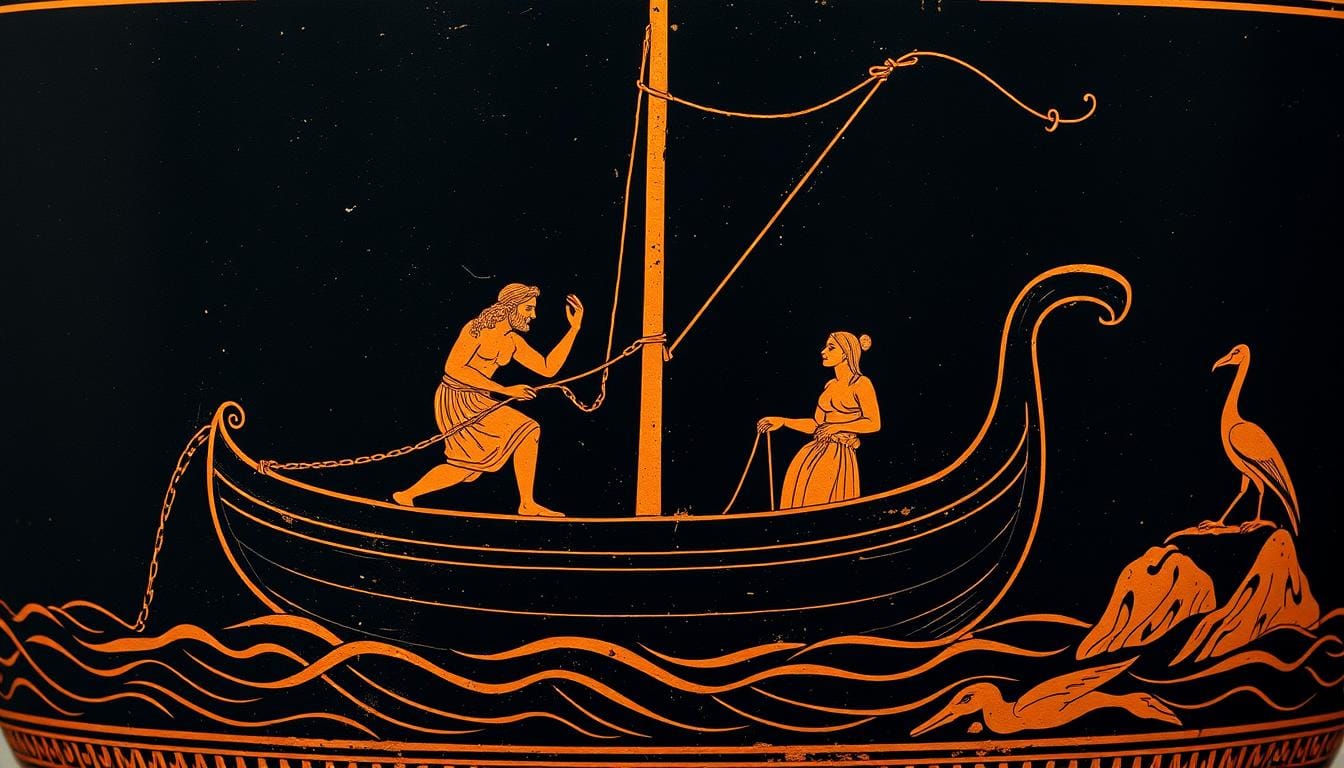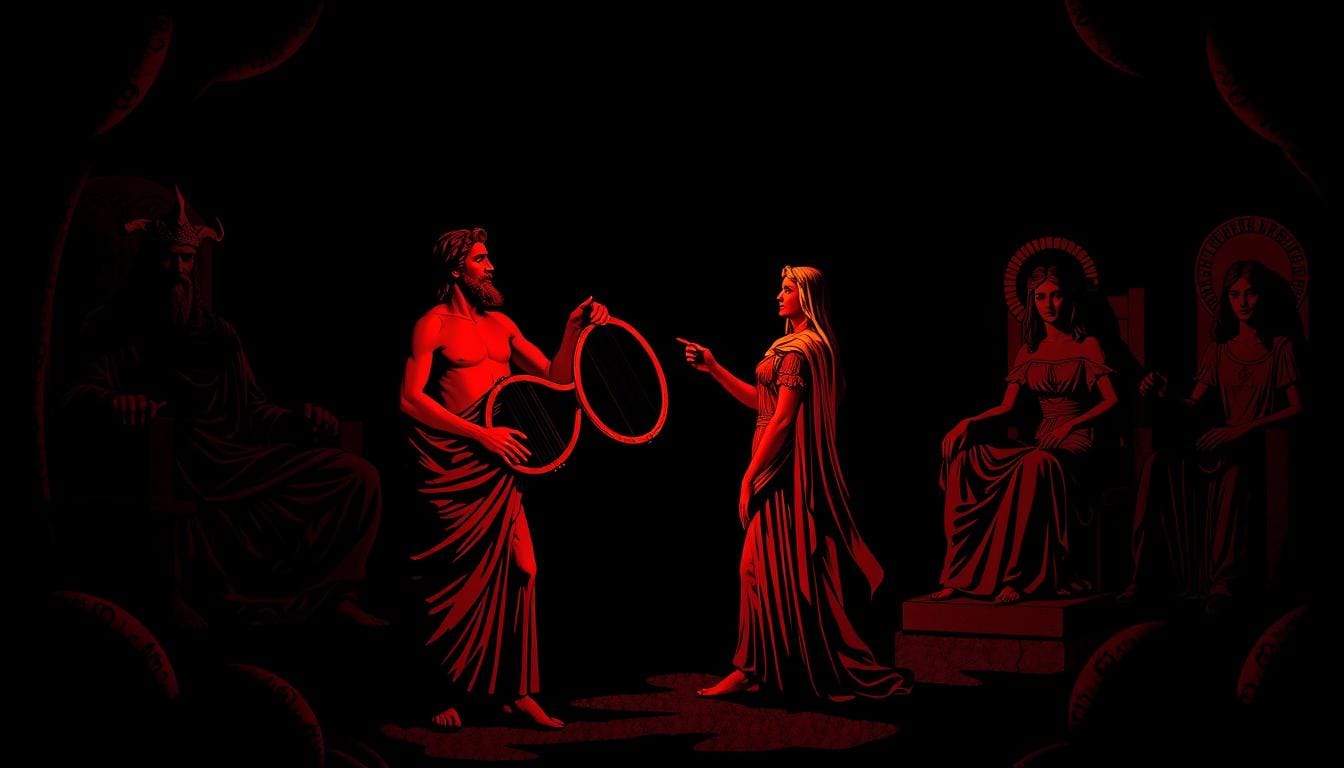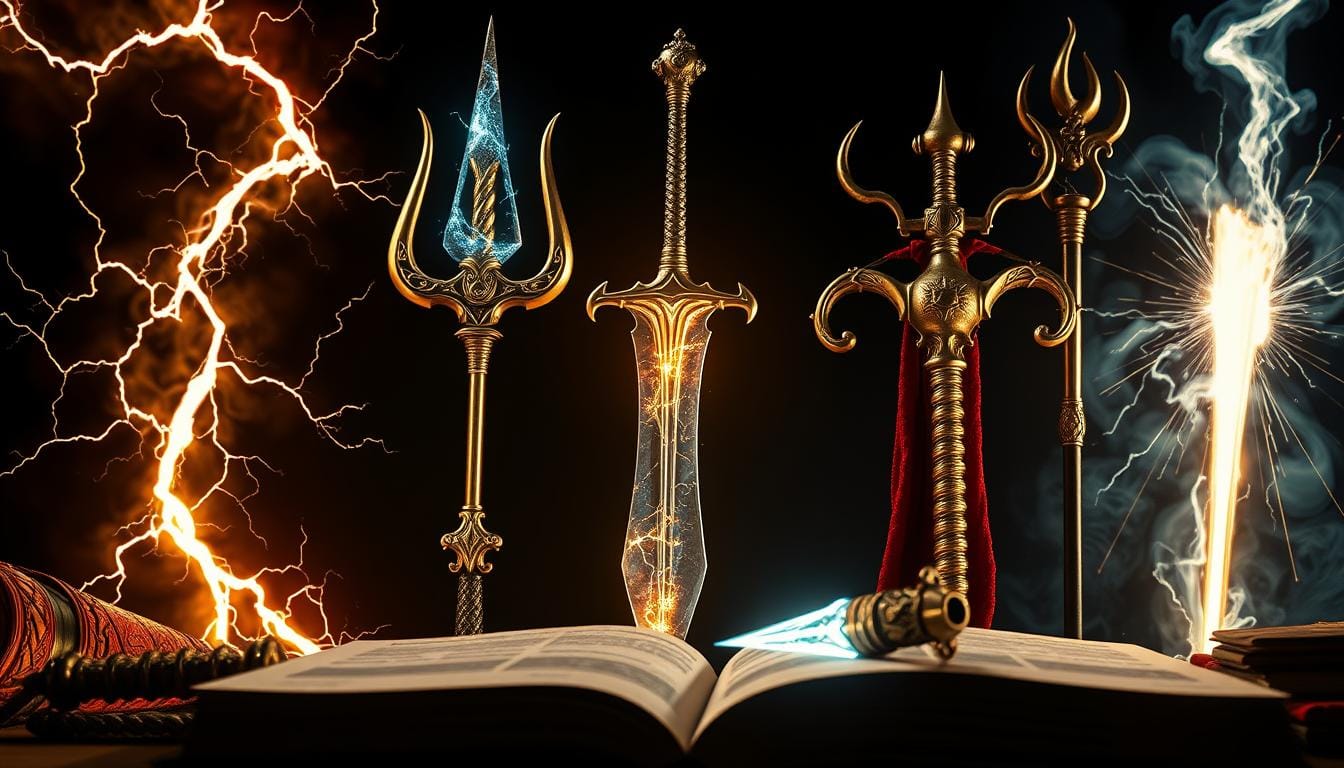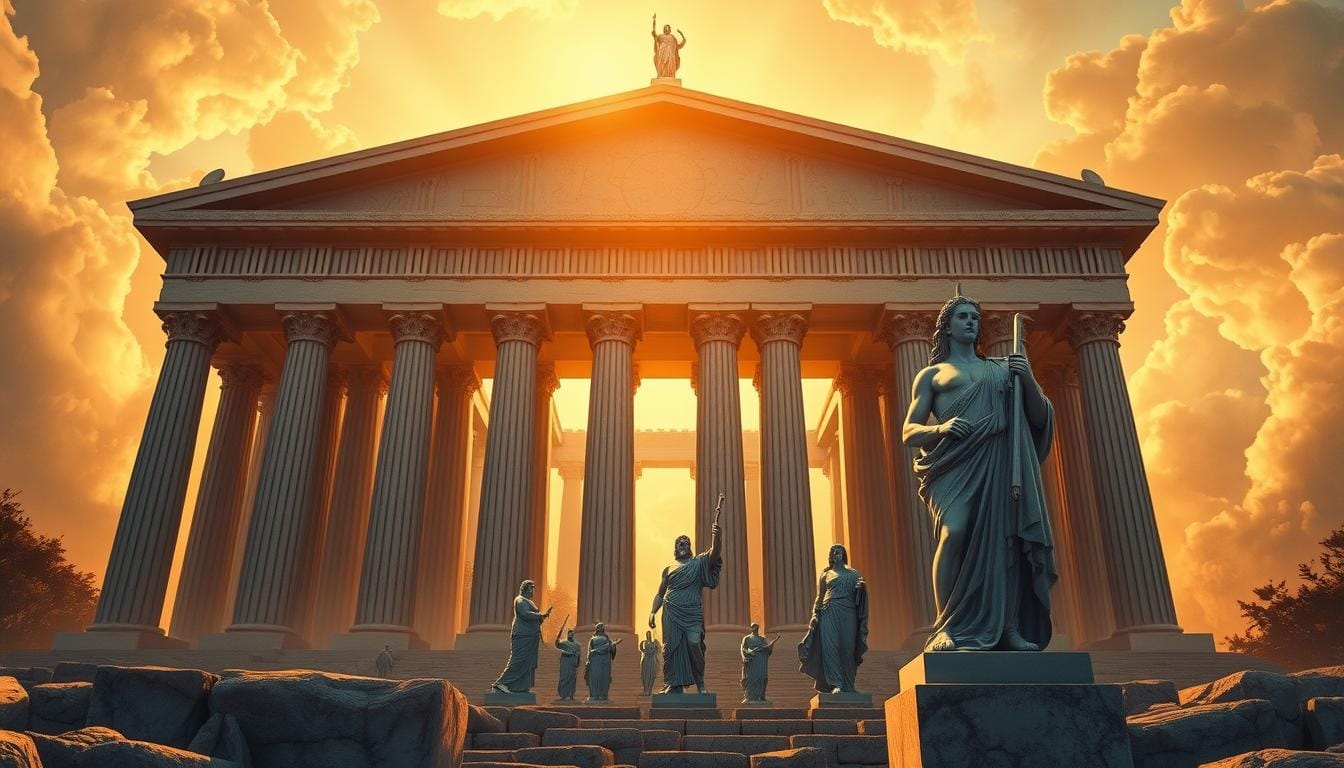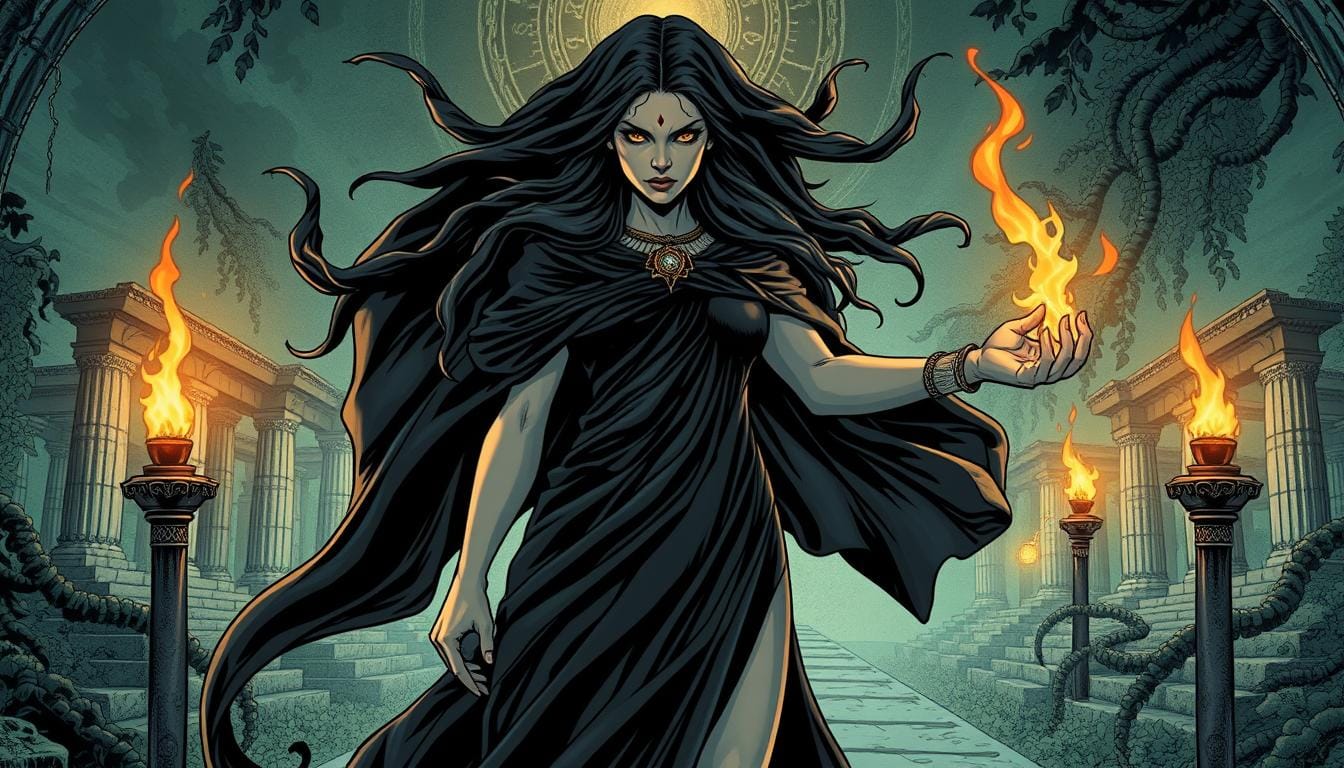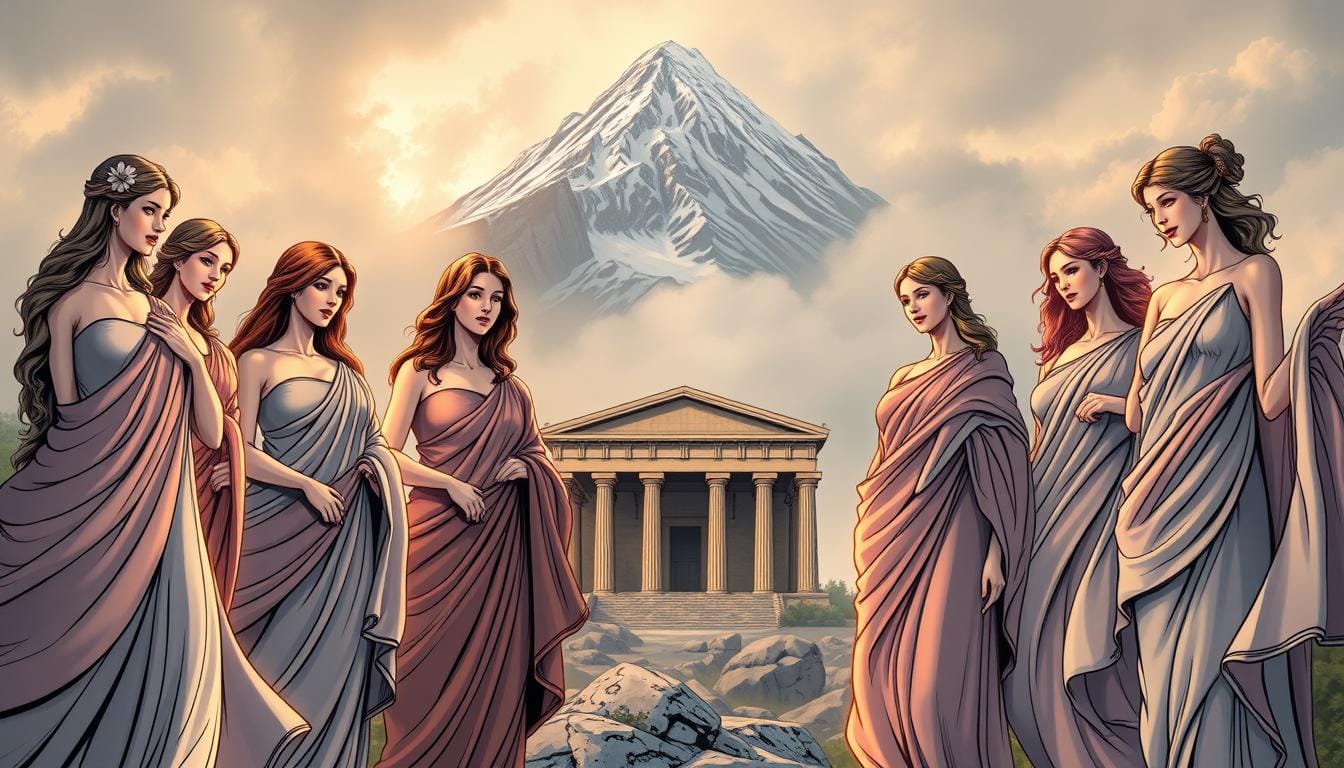Did you know ancient warriors in Sparta prayed to the same goddess who inspired romantic poetry? Aphrodite, the enchanting goddess of love and beauty, was also a war deity in several Greek cities. This shows how complex and fascinating she was in Greek mythology.
She was more than just a figure in romantic tales. Aphrodite was respected in many areas. She ruled over passion and desire, and also over the sea and ships. Her influence was felt in both war and love, making her a key Olympian god.
The ancient world knew her through symbols like seashells, roses, doves, and swans. These symbols showed her wide range of powers. Her stories tell of her kindness and her fierce anger.
Key Takeaways
- Aphrodite served as both a love deity and war goddess in ancient Greek cities like Sparta and Thebes
- Her worship extended beyond romance to include seafaring, maritime protection, and military victory
- Major symbols included seashells, roses, myrtles, doves, sparrows, and swans representing her diverse powers
- She possessed a dual nature as both a benevolent protector and a vengeful force when angered
- Her influence shaped ancient Greek culture across multiple domains including warfare, navigation, and relationships
- Aphrodite remains one of the most widely recognized figures from classical mythology today
1. Introduction to Aphrodite
Aphrodite is a goddess like no other, with origins that weave together Greek mythological traditions. She’s not just about love; she’s about the deep connections that shape our lives. Her influence touches on art, beauty, and the human quest for connection.
Her reach was vast, from small fishing towns to big cities. People sought her favor for love and beauty. Her stories ask profound questions about love, desire, and beauty’s power to change us.
Mythological Origins
Aphrodite’s birth has two stories, each showing a different side of her divine nature. These tales reflect ancient Greek values and her complex character.
Hesiod’s account tells of her coming from sea foam. This happened after Cronus cut off Uranus’s genitals and threw them into the sea. The foam then became Aphrodite, named after the Greek word *aphros*, meaning foam.
This story highlights her connection to the sea and creation. It shows love and beauty can come from chaos and conflict.
Homer’s version shows her as Zeus’s daughter, part of the divine family. This makes her part of the established order, showing love’s civilized side.
Both stories have deep meanings in Greek culture. They explore love’s wild side and its role in society and family.
Cultural Significance
Aphrodite’s worship was influenced by ancient Near Eastern traditions. These traditions were already well-established before Greek culture reached its peak.
The Phoenician goddess Astarte was a key influence on Aphrodite. Astarte was about love, fertility, and war. This mix defined Aphrodite’s complex nature. Greek sailors and merchants, who often met Phoenicians, adopted these ideas.
Even further back, Ishtar of Mesopotamia and Inanna of Sumeria also influenced Aphrodite. These goddesses ruled over love, beauty, and war. Their stories and symbols show how ideas spread through ancient trade routes.
“Love is the bridge between two hearts, but also the battlefield where souls are won and lost.”
This blending made Aphrodite uniquely Greek. She became a symbol of Greek values on beauty, relationships, and passion’s role in society.
Her impact went beyond worship. Artists, poets, and people looked to her for inspiration. She showed that beauty and love are essential, not just luxuries.
2. Aphrodite in Greek Mythology
Aphrodite is a key figure in Greek myths, known for her divine love and power. She was both respected and feared. Her stories show how desire and its consequences were viewed in ancient Greece.
She was involved in many adventures that changed the lives of gods and mortals. Her influence reached from Mount Olympus to Troy. These stories show how love and desire can change history.
Major Myths and Stories
Aphrodite’s marriage to Hephaestus was troubled. The gods paired her with the lame god of fire and metalworking. But Aphrodite was unhappy in this union.
Her affair with Ares, the god of war, was famous. They met in secret until Helios, the sun god, found out. Hephaestus then trapped them in bed with an invisible net.
The gods laughed at the sight, but the goddesses were ashamed. This story warns of the dangers of cheating on your partner.

Aphrodite’s love for Adonis was tragic. She warned him to avoid dangerous beasts, but he ignored her. A wild boar killed him, leaving Aphrodite heartbroken.
Her tears and his blood created the anemone flower. This myth explains the seasons and shows gods can feel deep loss.
The Judgment of Paris was a key moment. Aphrodite, Hera, and Athena competed for a golden apple. Paris chose Aphrodite, and she gave him Helen of Troy, starting the Trojan War.
Relationships with Other Gods
Aphrodite had complex relationships with other gods. These alliances and rivalries had big consequences. Her connections with other deities shaped the world of Greek myths.
Poseidon, the sea god, was one of her lovers. They had children like Rhodos and Eryx. This strengthened her power over the sea.
Hermes, the messenger god, was also a lover of Aphrodite. Their child, Hermaphroditus, had both male and female traits. This child symbolized the mix of masculine and feminine.
Her bond with Dionysus, the god of wine, was about pleasure and joy. Together, they influenced festivals and celebrations in Greece.
Her love for Anchises, a mortal, was significant. He was the father of Aeneas, who founded Rome. Aphrodite disguised herself to be with him.
Aphrodite also loved other mortals, but these relationships often ended badly. Her stories show the risks of loving a god.
| Divine Partner | Relationship Type | Notable Offspring | Mythological Significance |
|---|---|---|---|
| Ares | Secret Affair | Eros, Phobos, Deimos | Union of love and war |
| Poseidon | Divine Romance | Rhodos, Eryx | Maritime influence expansion |
| Hermes | Brief Liaison | Hermaphroditus | Gender duality symbolism |
| Anchises | Mortal Seduction | Aeneas | Foundation of Roman lineage |
Aphrodite’s stories make her a complex figure in Greek myths. She showed the power of love and its dangers. Her tales continue to captivate us, exploring themes of desire, jealousy, and the consequences of our actions.
3. Symbols Associated with Aphrodite
Sacred symbols around Aphrodite told stories of her divine nature. They helped worshippers understand her mystical powers. Each symbol carried deep spiritual meaning, connecting believers to her divine realm.
These symbols were seen in temples, artwork, and ceremonies in ancient Greece. They created a visual language that spoke to the hearts of her followers. They also helped people recognize Aphrodite’s presence in their daily lives.
The Dove and the Swan
Doves were Aphrodite’s most beloved birds. They represented peace, love, and fertility in ancient Greek culture. Their soft cooing sounds reminded people of tender whispers between lovers.
Ancient Greeks believed doves carried messages of love from the goddess. They often appeared in wedding ceremonies and romantic rituals. Their white feathers symbolized the pure nature of true love.
Swans had different but equally important meanings for Aphrodite. They represented transformation and divine beauty. Their elegant movements on water reminded worshippers of the goddess’s own grace.
Greek myths tell stories of swans appearing during important moments in Aphrodite’s life. The birds served as her sacred messengers and companions. Their presence marked places where the goddess had walked or blessed with her divine touch.
The Rose and the Myrtle
Roses became the ultimate symbol of passionate love under Aphrodite’s influence. The flower’s beauty and sweet fragrance captured the essence of romantic desire. Red roses represented the intensity of true love.
Ancient Greeks planted rose gardens near Aphrodite’s temples as offerings. The thorns reminded worshippers that love could bring both joy and pain. This duality reflected the goddess’s complex nature and her power over human emotions.
Myrtle trees held equally sacred status in Aphrodite’s symbolic world. These evergreen plants represented marriage and domestic happiness. Brides wore myrtle crowns during wedding ceremonies to invoke the goddess’s blessings.
The myrtle’s ability to stay green year-round symbolized eternal love. Its small white flowers represented the purity of committed relationships. Ancient Greeks believed myrtle could protect marriages from harm and strengthen the bonds between spouses.
Other important symbols included seashells, which connected to her birth from sea foam. Mirrors reflected her domain over beauty and vanity. Her magical girdle could inspire irresistible desire in anyone who saw the wearer. These symbols worked together to create a complete picture of the ancient Greek goddess and her divine powers over love and beauty.
4. Worship and Temples Dedicated to Aphrodite
Ancient civilizations built stunning temples to honor Aphrodite, the goddess of desire. Her worship spread across the Mediterranean, creating sacred sites for love and beauty. These temples were centers of religious life, attracting pilgrims from far and wide.
The religious practices around Aphrodite showed her dual nature. Communities developed unique rituals to honor her and meet their needs for love, fertility, and protection.
Sacred Sanctuaries Across the Ancient World
The most famous temple was at Paphos in Cyprus, where Aphrodite myths say she first emerged. This sanctuary was the main pilgrimage site for her worshippers. The temple featured a unique cone-shaped stone, not a traditional statue.
Pilgrims from across the Mediterranean came to witness the sacred rituals at Paphos. The temple’s priests performed elaborate ceremonies with music, dancing, and offerings. The sanctuary’s influence extended far beyond Cyprus, shaping religious practices elsewhere.

Corinth housed another magnificent temple, famous throughout the ancient world. This sanctuary had hundreds of sacred attendants serving the goddess of desire. The temple’s wealth and influence made it a powerful religious institution in Greece.
The island of Cythera claimed to be Aphrodite’s first landing place. Its temple attracted devotees who believed this location held special power for matters of the heart. Archaeological evidence shows continuous worship at this site for over a thousand years.
Athens had its own important sanctuary dedicated to Aphrodite, reflecting her significance in the city’s religious life. The Athenian temple focused on her role as a protector of the city and its people. During conflicts, citizens would gather here to seek her divine intervention.
“The temples of Aphrodite were not merely places of worship, but centers of community life where people gathered to celebrate the most fundamental human experiences.”
The archaeological site of Aphrodisias in Turkey became a major center during the Roman Empire. This city was entirely dedicated to the goddess, featuring elaborate sculptures and architectural marvels. The site demonstrates how Aphrodite worship evolved and adapted to different cultures.
Sacred Ceremonies and Divine Offerings
The annual Aphrodisia festival was the most important celebration honoring the goddess of desire. Communities held this midsummer festival with great enthusiasm, featuring processions, theatrical performances, and communal feasts. The timing coincided with the season of love and fertility, making it special for participants.
During Aphrodisia, devotees brought elaborate offerings to demonstrate their devotion. These gifts included fresh flowers, such as roses and myrtle, which held special significance in Aphrodite myths. Worshippers also offered precious jewelry, perfumes, and beautifully crafted objects.
Sacred rituals involved the burning of incense, creating aromatic clouds believed to carry prayers to the goddess. Different regions developed their own variations of these ceremonies, incorporating local customs and traditions while maintaining core elements of Aphrodite worship.
| Temple Location | Primary Features | Special Rituals | Cultural Significance |
|---|---|---|---|
| Paphos, Cyprus | Cone-shaped sacred stone | Sea foam ceremonies | Birthplace pilgrimage site |
| Corinth, Greece | Hundreds of attendants | Sacred prostitution | Wealthy religious center |
| Cythera, Greece | Cliffside sanctuary | First landing rituals | Original worship site |
| Aphrodisias, Turkey | Elaborate sculptures | Roman imperial ceremonies | Cultural fusion center |
Animal sacrifices were another important part of worship, though they varied by location and occasion. Doves were considered sacred to the goddess. These gentle birds symbolized the peaceful aspects of love and devotion.
Purification rituals prepared worshippers for important ceremonies and festivals. Devotees would bathe in sacred springs or seawater, believing this cleansed them spiritually. These practices connected worshippers to the natural elements associated with Aphrodite.
The goddess of desire inspired devotees to create beautiful flower garlands for her temples and statues. These colorful decorations transformed sacred spaces into gardens of earthly paradise. The practice of giving flowers continues to influence modern expressions of love and devotion.
Regional variations in worship practices reflected local needs and customs while maintaining connection to core Aphrodite myths. Coastal communities emphasized her connection to the sea, while agricultural regions focused on her fertility aspects. This adaptability helped her worship survive and thrive across diverse cultures.
5. Aphrodite's Influence on Art and Literature
The ancient goddess Aphrodite has a big impact on art and literature. Her beauty and complex nature have inspired many for thousands of years. Her stories of love, passion, and desire keep artists and writers coming back for more.
Aphrodite has been a muse and subject for ages. Her image has changed over time and cultures. But her essence of beauty remains in the hearts of artists and writers.
Depictions in Ancient Art
Ancient artists changed how they showed divine figures with Aphrodite. Praxiteles’ famous statue for the Cnidians was a game-changer. It was the first full-scale female nude in Greek mythology art.
The Cnidian Aphrodite set new standards for art. The Venus de Milo was inspired by this work. These sculptures showed different sides of the goddess.
Pompeii’s frescoes show another side of art. These colorful paintings showed Aphrodite in mythological scenes. They show how Roman artists used Greek traditions in their own way.
Aphrodite in Modern Literature
Literature has featured Aphrodite from the start. Homer’s Iliad shows her as complex, with divine powers and human feelings. Sappho’s Ode to Aphrodite gives a personal look at the goddess and love.
Renaissance artists like Sandro Botticelli brought new life to old themes. His The Birth of Venus (c. 1485) is a famous painting of the ancient goddess. It mixed classical myths with Renaissance art.
Today, authors keep Aphrodite’s myths alive for new readers. They explore femininity, power, and relationships through her. These works show how ancient stories are relevant today.
| Time Period | Notable Works | Artistic Innovation | Cultural Impact |
|---|---|---|---|
| Ancient Greece | Praxiteles’ Cnidian Aphrodite | First full-scale female nude | Established artistic standards |
| Hellenistic Period | Venus de Milo | Refined sculptural techniques | Symbol of classical beauty |
| Renaissance | Botticelli’s Birth of Venus | Mythological subject revival | Bridged ancient and modern art |
| Modern Era | Contemporary literature | Psychological character depth | Feminist reinterpretations |
Aphrodite’s influence on art and literature spans millennia and keeps growing. Her timeless appeal will continue to inspire artists and writers. Aphrodite remains a symbol of beauty, love, and artistic inspiration.
6. Aphrodite's Dual Nature: Love and War
Aphrodite was more than just the goddess of beauty. She was also a fierce warrior. This deity of love, beauty and passion had a complex character. Ancient people saw her as both loving and warlike.
The Greeks saw a link between love and war. Both could make people do amazing things or cause harm. They understood that love and war were both powerful forces.

The Balance of Love and Conflict
Ancient Greeks saw a deep connection between passion and violence. Aphrodite showed this perfectly. Her worship showed that beauty and passion could lead to both creation and destruction.
In Laconia, Aphrodite was seen as a warrior goddess. This shows how different places saw her in different ways. The Spartans, known for their military, saw her as a warrior.
Pausanias, a Greek traveler, wrote about Aphrodite’s warrior side. In Sparta, she was known as Aphrodite Areia, the warlike one. This was different from her usual role as a gentle goddess of love and beauty.
The oldest statues of her in Sparta and Cythera showed her with arms. These images showed her ready for battle. Scholars believe these warrior aspects were part of her worship from the start.
| Aspect | Love Domain | War Domain | Shared Elements |
|---|---|---|---|
| Emotions | Desire, affection, tenderness | Rage, vengeance, fierce loyalty | Intense passion, overwhelming feelings |
| Actions | Romance, marriage, fertility | Battle, conflict, punishment | Bold decisions, life-changing events |
| Symbols | Roses, doves, mirrors | Weapons, armor, shields | Fire, golden objects, sacred animals |
| Worship Sites | Cyprus, gardens, temples | Sparta, Laconia, fortified areas | Coastal regions, mountain sanctuaries |
Stories Reflecting Her Duality
Myths about Aphrodite show her love and war sides. These stories show how ancient people saw her complete character. The deity of love could be both caring and fierce, depending on the situation.
The Trojan War is a famous example of her dual nature. She gave Helen to Paris, leading to ten years of war. This shows how love can lead to conflict.
Her relationship with Ares, the god of war, shows her duality. Their children, like Eros and Deimos, brought both love and fear. Eros brought desire, while Deimos and Phobos brought fear and panic to battlefields.
Stories of her vengeance show her warrior side. When people challenged her beauty or scorned love, she punished them harshly. The story of Hippolytus is a good example of this.
Psyche’s trials also show Aphrodite’s duality. Aphrodite’s jealousy led to dangerous tasks for Psyche. Yet, the story celebrates love’s victory over adversity.
These myths teach us about human nature. They show that passion can lead to great achievements or terrible destruction. Love and war both need respect and careful handling.
The ancient Greeks understood Aphrodite’s dual nature deeply. Modern psychology also sees a link between love and aggression. The Greeks just personified these complex relationships in their goddess of beauty and passion.
7. Aphrodite in Roman Culture
The transformation of Greek Aphrodite into Roman Venus is a captivating tale. When Romans met this ancient Greek goddess, they didn’t just copy her. They made her their own, reflecting their values and dreams.
Romans valued both power and beauty. This changed how they saw and honored the goddess. Venus became more than a beauty and love icon.
The Transformation to Venus
The Romans turned Aphrodite into Venus, adding new layers to her role. She kept her power over love and beauty but gained more. Venus became linked with wealth, victory, and state power.
This change was strategic. The Julian family, like Julius Caesar and Augustus, claimed Venus as their ancestor. This made her a key figure in Roman society.
Roman writers celebrated Venus as a national symbol. She was not just about love but also the force behind their empire’s growth. The goddess stood for fertility, abundance, and military triumphs.
Venus got grand temples across the Roman world. Her worship was deeply connected to Roman identity and power. People saw her as a guardian of their civilization and a source of strength.
Comparisons between Aphrodite and Venus
Aphrodite and Venus shared some traits but were shaped differently by culture. The mythological figure of Aphrodite focused on personal love and desire. Venus, on the other hand, touched on broader social and political themes.
Here are some key differences:
- Scope of influence: Aphrodite was about personal love; Venus was about state affairs
- Political role: Aphrodite was apolitical; Venus was central to Roman power
- Cultural symbolism: Aphrodite was about Greek beauty; Venus was about Roman power and wealth
- Literary treatment: Greeks saw Aphrodite as unpredictable; Romans saw Venus as a stabilizing force
The Roman poet Lucretius called Venus “Genetrix” – the creative force in the world. This title showed a big change in understanding. Aphrodite created through passion, while Venus created through purposeful generation.
Both goddesses were tied to nature and fertility. But Venus also carried the weight of Roman military victories and expansion. She became the divine mother of the Roman people, not just their love goddess.
This adaptation kept the goddess relevant across cultures. By evolving to meet new needs, she showed the enduring power of ancient deities in changing times.
8. Modern Interpretations of Aphrodite
Aphrodite’s power to inspire creativity and personal change is timeless. She continues to captivate people through various media and spiritual practices. Her lasting appeal shows that love and beauty symbolism is as relevant today as it was in ancient times.
Today, creators retell her stories for a new audience. They mix old and new themes. This blend offers fresh views on ancient wisdom.
Aphrodite in Popular Culture
Hollywood often uses Aphrodite myths in romantic and fantasy movies. TV shows dive into her relationships with gods through drama. Video games let players experience her divine powers in virtual realms.
The fashion world is inspired by her beauty. Designers aim to capture her elegance in their collections. Advertisements use her image to sell items related to love and luxury.
Sandro Botticelli’s Birth of Venus is a famous painting. It continues to influence artists today. They create new takes on her emergence from the sea.
The term aphrodisiac keeps her name in our language. It refers to things that boost romantic desire. This shows her lasting influence on culture.
The Goddess as a Symbol of Empowerment
Modern feminism has redefined Aphrodite as a symbol of female power. They celebrate her control over her sexuality and choices. This view goes beyond just physical beauty.
Neopagan religions honor her divine feminine energy. The Church of Aphrodite, Wicca, and Hellenism include her in their practices. They see her as a guide for self-love and empowerment.
People find wisdom in her ancient stories. They apply her lessons to today’s relationship issues. Her myths offer guidance on passion and independence.
Women’s empowerment groups use her image to boost confidence. They encourage celebrating natural beauty. This approach turns love and beauty symbolism into tools for growth.
Social media influencers share content inspired by her. They promote self-acceptance and inner strength. These interpretations help people connect with their divine nature.
9. Aphrodite's Influence on Relationships and Love
Aphrodite’s wisdom on passion and connection is timeless. The goddess of desire from Greek mythology inspires those seeking love and personal growth. Her teachings on human connection are as relevant today as they were in ancient times.
Modern relationship experts often echo Aphrodite’s insights. Her magical girdle shows the power of confidence and self-assurance in attracting others.
Lessons from Aphrodite for Modern Relationships
Aphrodite’s stories teach us about romantic partnerships. Her relationships with divine and mortal lovers show the importance of attraction and commitment. Passion and desire are key to healthy relationships, just as Aphrodite taught.
Her connection to the Graces and Seasons teaches us about relationship cycles. Love blooms like spring, and sometimes we need patience through winter. Understanding these cycles helps couples face tough times together.
Aphrodite’s stories also warn against jealousy and possessiveness. Her conflicts with other goddesses show how these emotions can harm relationships. Modern couples can learn to balance independence and partnership by studying her myths.
- Embrace passion while maintaining personal identity
- Recognize that relationships have natural seasons
- Address jealousy before it becomes destructive
- Value both physical and emotional attraction
- Communicate desires openly and honestly
The Goddess and Self-Love
Aphrodite’s focus on beauty and self-care is key to self-acceptance today. The goddess of desire knew true beauty comes from within. Her magical girdle enhanced the wearer’s confidence and self-love.
Practicing self-care rituals inspired by Aphrodite can boost well-being. Beauty routines, sensual pleasures, and body appreciation are essential for healthy relationships. You cannot truly love another until you love yourself.
Her role in fertility and marriage in Greek mythology shows self-love leads to better partnerships. When Zeus called marriages “her work,” he recognized Aphrodite’s influence starts with individual wholeness. People who embrace their inner goddess attract more fulfilling relationships.
Modern psychology backs Aphrodite’s wisdom on self-acceptance. Confidence and self-worth are the most attractive qualities. Her teachings encourage embracing strength and vulnerability as natural parts of human experience.
10. Conclusion: The Everlasting Legacy of Aphrodite
The story of Aphrodite – Goddess of Love and Beauty has captured hearts for centuries. She has become a part of human culture, going beyond her mythological roots.
Revisiting Love and Beauty Through Her Lens
Aphrodite’s complex nature offers deep insights into love. She shows that beauty is both gentle and strong. Her myths teach us that true love is filled with passion, sacrifice, and growth.
Today, her stories offer wisdom on relationships, self-acceptance, and being brave. Aphrodite reminds us that love is not always easy or calm. Her dual role as lover and warrior teaches us that real connections need effort and sometimes conflict.
Final Thoughts on Aphrodite's Relevance Today
Aphrodite’s influence is seen in Western art and literature, making her a key part of culture. She is a major deity in modern Neopagan religions, guiding followers in love matters. The term “aphrodisiac” comes from her name, showing her lasting impact on language.
Her appeal is timeless because she represents basic human experiences. Through ancient sculptures or modern novels, Aphrodite inspires us to explore love, beauty, and personal power.
Listen to the Myth: Discover more about Aphrodite’s stories through our featured podcast series exploring Greek mythology.
